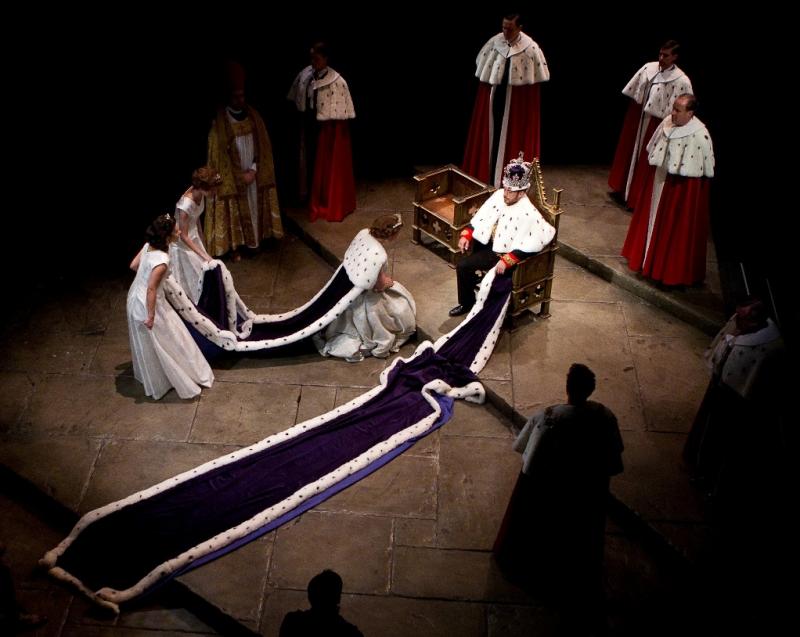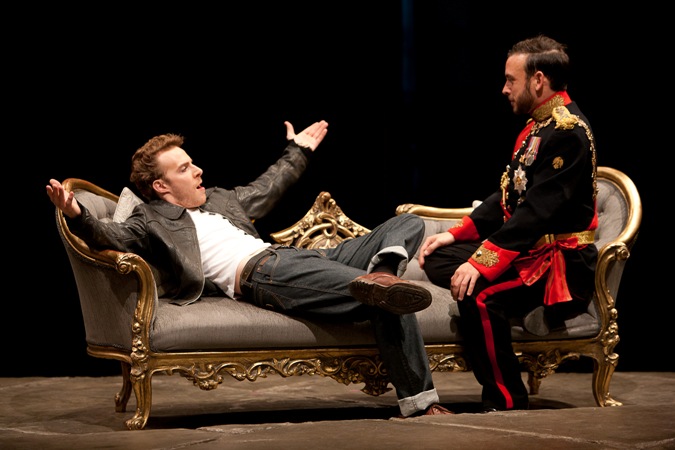Edward II, Royal Exchange, Manchester | reviews, news & interviews
Edward II, Royal Exchange, Manchester
Edward II, Royal Exchange, Manchester
Haunting revival finds a Norman king's immolation updated to the 1950s

This is not exactly Edward II the musical. There’s no singing, but music plays a leading role. It is the food of love of the sort that dared not speak its name – and there is excess of it for my taste. The idiom is jazz of the edgy sort fashionable in Paris in the 1950s, reflecting pretty boy Piers Gaveston’s exile there, where he has been banished by Edward I for getting too close to his wayward son.
Director Toby Frow chooses to move Marlowe’s play nearly 650 years on to the 1950s, notable amongst other things for the newsworthiness of homosexual causes célèbres, as the timeline diagram in the theatre programme illustrates. Names such as Manchester’s own Alan Turing, John Gielgud, Peter Wildeblood and Lord Montagu, to name but four, resonated across the decade in which Sir John Wolfenden’s committee recommended the legalisation of same-sex activity between consenting adults.
The entertainment begins in a jazz club, created by designer Ben Stones and based on the Mars Club in Paris, outside the suspended lunar module that is the Royal Exchange Theatre. We are invited (not obligatory) to sit at tables, listen to live jazz and enjoy a cocktail. Not immediately relevant to Marlowe’s dreadful drama or appropriate in mood perhaps, but, hey, we’re on an adventure here. You could argue, if you were seeking “relevance”, that just as Edward I’s stable state of 1307 was about to turn chaotic with the succession of his son upon his death, so the 1950s turned out to be fast-changing times, leading to the self-indulgent Sixties.
So, after 45 minutes of jazz, to the play – and the theatre - proper. Gaveston, in a French café, receives the news that Edward I is dead and rejoices at the prospect of returning to England and his lover. The setting becomes stark – essentially a broad-stepped stone floor - putting the focus on the actors. There is little sense of place or scale.
The play is all about personal passion, human weakness and fatal endings. As the long subtitle declares, it tells the tale of "The Troublesome Reign of Edward II, King of England, and the Lamentable Death of Proud Mortimer". The trouble with updating, of course, is dealing with those quaint old customs of noble banishment, royal imprisonment and murderous executions. I know, I know, the play’s the thing and Frow’s version, though flawed, is faithful to the inexorable drive of Marlowe’s work, first produced around 1593, even if set around 1953. However anachronistically, the young Edward III (an impressive cameo debut by 13-year-old Jonah Rzeskiewicz) is finally presented with Mortimer’s severed head in a bloody bag. But there are inconsistencies. We get a formal robed coronation for Edward II, but his son’s enthronement is heard on a portable radio by two old men sitting at the roadside eating fish and chips out of paper. There is a risible moment when truncheon-toting bobbies in ill-fitting helmets chase the earls and Gaveston around rather in the style of the Keystone Cops.
 In the title role, Chris New develops the character from a dapper, dallying, feckless individual to a pitiable man tortured in the extreme both mentally and physically. His relationship with Gaveston, played by Samuel Collings (pictured right with New) with an energetic devil-may-care attitude as a James Dean lookalike in jeans and T-shirt, is convincingly passionate and cloying. “Sooner shall the sea o’erwhelm my land than bear the ship that shall transport thee hence!” - thus he sums up his attitude to the dilemma of Gaveston versus country. He treats his wife, Queen Isabella (a rather muted Emma Cuniffe), with awful disdain, except when she also appears to favour Gaveston.
In the title role, Chris New develops the character from a dapper, dallying, feckless individual to a pitiable man tortured in the extreme both mentally and physically. His relationship with Gaveston, played by Samuel Collings (pictured right with New) with an energetic devil-may-care attitude as a James Dean lookalike in jeans and T-shirt, is convincingly passionate and cloying. “Sooner shall the sea o’erwhelm my land than bear the ship that shall transport thee hence!” - thus he sums up his attitude to the dilemma of Gaveston versus country. He treats his wife, Queen Isabella (a rather muted Emma Cuniffe), with awful disdain, except when she also appears to favour Gaveston.
New builds to a searing finale, in which he is imprisoned by men in white suits and gives up his throne in favour of his son. In a long scene with echoes of Guantánamo and recent British Army atrocities, he suffers immersion in a sewer, waterboarding, hooding and, finally, the harrowing red-hot poker treatment. The latter is delivered by Lightborn (Lucifer) in chilling style by Samuel Collings. Frow spares us nothing. You are rarely likely to experience a more shockingly hypnotic sequence in a drama.
Edward II was last performed at this theatre 25 years ago. Nicholas Hytner’s production, with Ian McDiarmid in the title role and Michael Grandage as Gaveston, lives vividly in the minds of those of us lucky enough to have experienced it - it still haunts me. The vision of New's Edward reaching his lowest pitiable degradation is likely to haunt me similarly.
Share this article
The future of Arts Journalism
You can stop theartsdesk.com closing!
We urgently need financing to survive. Our fundraising drive has thus far raised £49,000 but we need to reach £100,000 or we will be forced to close. Please contribute here: https://gofund.me/c3f6033d
And if you can forward this information to anyone who might assist, we’d be grateful.

Subscribe to theartsdesk.com
Thank you for continuing to read our work on theartsdesk.com. For unlimited access to every article in its entirety, including our archive of more than 15,000 pieces, we're asking for £5 per month or £40 per year. We feel it's a very good deal, and hope you do too.
To take a subscription now simply click here.
And if you're looking for that extra gift for a friend or family member, why not treat them to a theartsdesk.com gift subscription?
more Theatre
 Ragdoll, Jermyn Street Theatre review – compelling and emotionally truthful
Katherine Moar returns with a Patty Hearst-inspired follow up to her debut hit Farm Hall
Ragdoll, Jermyn Street Theatre review – compelling and emotionally truthful
Katherine Moar returns with a Patty Hearst-inspired follow up to her debut hit Farm Hall
 Troilus and Cressida, Globe Theatre review - a 'problem play' with added problems
Raucous and carnivalesque, but also ugly and incomprehensible
Troilus and Cressida, Globe Theatre review - a 'problem play' with added problems
Raucous and carnivalesque, but also ugly and incomprehensible
 Clarkston, Trafalgar Theatre review - two lads on a road to nowhere
Netflix star, Joe Locke, is the selling point of a production that needs one
Clarkston, Trafalgar Theatre review - two lads on a road to nowhere
Netflix star, Joe Locke, is the selling point of a production that needs one
 Ghost Stories, Peacock Theatre review - spirited staging but short on scares
Impressive spectacle saves an ageing show in an unsuitable venue
Ghost Stories, Peacock Theatre review - spirited staging but short on scares
Impressive spectacle saves an ageing show in an unsuitable venue
 Hamlet, National Theatre review - turning tragedy to comedy is no joke
Hiran Abeyeskera’s childlike prince falls flat in a mixed production
Hamlet, National Theatre review - turning tragedy to comedy is no joke
Hiran Abeyeskera’s childlike prince falls flat in a mixed production
 Rohtko, Barbican review - postmodern meditation on fake and authentic art is less than the sum of its parts
Łukasz Twarkowski's production dazzles without illuminating
Rohtko, Barbican review - postmodern meditation on fake and authentic art is less than the sum of its parts
Łukasz Twarkowski's production dazzles without illuminating
 Lee, Park Theatre review - Lee Krasner looks back on her life as an artist
Informative and interesting, the play's format limits its potential
Lee, Park Theatre review - Lee Krasner looks back on her life as an artist
Informative and interesting, the play's format limits its potential
 Measure for Measure, RSC, Stratford review - 'problem play' has no problem with relevance
Shakespeare, in this adaptation, is at his most perceptive
Measure for Measure, RSC, Stratford review - 'problem play' has no problem with relevance
Shakespeare, in this adaptation, is at his most perceptive
 The Importance of Being Earnest, Noël Coward Theatre review - dazzling and delightful queer fest
West End transfer of National Theatre hit stars Stephen Fry and Olly Alexander
The Importance of Being Earnest, Noël Coward Theatre review - dazzling and delightful queer fest
West End transfer of National Theatre hit stars Stephen Fry and Olly Alexander
 Get Down Tonight, Charing Cross Theatre review - glitz and hits from the 70s
If you love the songs of KC and the Sunshine Band, Please Do Go!
Get Down Tonight, Charing Cross Theatre review - glitz and hits from the 70s
If you love the songs of KC and the Sunshine Band, Please Do Go!
 Punch, Apollo Theatre review - powerful play about the strength of redemption
James Graham's play transfixes the audience at every stage
Punch, Apollo Theatre review - powerful play about the strength of redemption
James Graham's play transfixes the audience at every stage
 The Billionaire Inside Your Head, Hampstead Theatre review - a map of a man with OCD
Will Lord's promising debut burdens a fine cast with too much dialogue
The Billionaire Inside Your Head, Hampstead Theatre review - a map of a man with OCD
Will Lord's promising debut burdens a fine cast with too much dialogue

Add comment